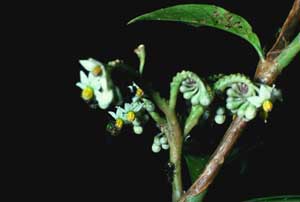|
|
 7 pollen as bait DHJanzen101022.jpg high resolution
|
|
|
The other bait for pollinators is pollen. Here, a small green bee holds tightly to the yellow anthers of a tropical solanaceous flower and buzzes its wings. The pollen shoots out of a pore at the end of the anther (see image DHJanzen101022.jpg below) onto the bee, much as salt would shoot out of a saltshaker held up side down and shaken violently. The bee then combs this pollen off of itself and takes it back to the nest as food for its larvae (see below). But, some of the pollen remains on the surface of the bee and then ends up on the stigma of another flower that it later visits. In effect, the plant is paying sperm for the service of pollen transport from one plant to another, and the mutualism is obvious. Bees, as we will see later, are really nothing more than hairy wasps that collect pollen on the hairs as food for their larvae, rather than being carnivorous predators as were their distant ancestors. In short, a bee may visit a flower for nectar (as do many other kinds of insects) and/or for pollen, and in either case, serve as a pollinator. There are many species of flowers that produce no nectar at all, with the bait being entirely pollen collected by a bee to take back to nest to provision larval cells. |
||
back to lecture slides
or skip to: